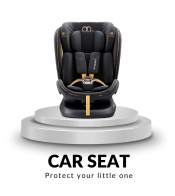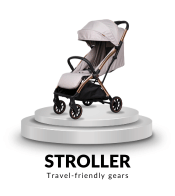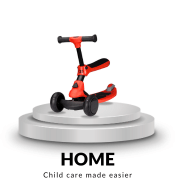Car Seat Information
Booster Seats in Malaysia: What Are They and When to Start Using Them?
Booster seats are an important part of ensuring that children are sufficiently protected in vehicles. In this talk, we will look at what booster seats are, how they work, and, most importantly, when they should be used in Malaysia. Understanding when to switch from various newborn car seats to booster seats is critical since it directly affects a child’s safety during automobile rides. This article seeks to educate Malaysian parents and carers with the information they need to make informed booster seat decisions, ultimately prioritising the safety and well-being of their young passengers.
Understanding Booster Seats
A booster seat is a fundamental element in child passenger safety, designed to bridge the gap between child car seats and adult seat belts. Its primary purpose is to elevate a child to a height where the seat belt fits them correctly. Booster seats serve as a crucial safety tool by ensuring that the seat belt crosses the child’s shoulder and chest rather than their neck and that the lap belt rests low on their hips instead of their abdomen.
By doing so, they provide the necessary support and restraint to protect children during vehicular journeys, preventing potential injuries in the event of an accident. Understanding how booster seats work to ensure proper seat belt fit is essential for parents and caregivers in Malaysia, as it directly contributes to the safety and well-being of young passengers on the road.
Age and Size Guidelines in Malaysia
In Malaysia, the recommended age and size criteria for using booster seats are crucial considerations for parents and caregivers. Generally, children are advised to transition to booster seats when they have outgrown their forward-facing child car seats, typically around the age of four to seven, and when they reach a height starting from minimum of 100 cm.
However, it’s important to note that parents should comply with the UNR standard, which is the R44 or R129, where childrens whose weight is less than 36kg, height less than 136cm, or aged below 12 years old are equipped with baby seat when travelling in private automobiles.

Importance of Booster Seats
The safety benefits of using booster seats cannot be overstated, particularly in Malaysia’s bustling traffic. These seats play a vital role in reducing the risk of injury for children in car accidents. They achieve this by effectively positioning the seat belt across a child’s shoulder and chest, preventing it from resting dangerously across their neck. Furthermore, booster seats ensure that the lap belt is correctly situated low on the hips rather than the abdomen, mitigating the potential for abdominal injuries.
Transitioning from Child Seats to Booster Seats
The timing of this transition depends on a few key factors, including the child’s age, height, and weight. As a general guideline, children typically make the switch to a booster seat when they have outgrown their forward-facing child safety seat, which often happens around the age of four to seven.
Bear in mind with the regulation of ECE R44/04 measured by weight & ECE R129 measured by height safety regulations under the United nation law. In any case, the transition should only occur when the child meets the recommended criteria, ensuring that the seat belt fits them correctly and provides optimal protection during car journeys.
Choosing the Right Booster Seat
To make an informed choice, it’s essential to consider the child’s size and age. Look for booster seats that are appropriate for the child’s height or weight, ensuring they meet the recommended criteria for a secure fit.
There are two primary types of booster seats: high-back boosters and backless boosters. High-back boosters provide head and neck support and are suitable for younger children, while backless boosters are designed for older kids.
Proper Installation and Use
Begin by positioning the booster seat on top of the vehicle seat to assist your children in using the seatbelt. Some booster seats also offer the option of ISOFIX lower anchorages installation for more stability. The child should sit comfortably in the booster seat with their back against the backrest, and their bottom should be positioned far back so that their knees bend naturally over the seat edge.
The seat belt should be threaded through the designated belt guides on the booster seat, making sure it lies flat across the child’s shoulder and chest, and that the lap belt fits low and snug over their hips, not across the abdomen. Regularly check the booster seat’s fit and the child’s comfort to guarantee that they remain optimally protected throughout the journey.
Additional Safety Tips
One of the most important is to ensure that the child remains securely buckled up throughout the entire journey. Make it a habit to check that the seat belt stays snugly in place, as children tend to squirm and adjust themselves during rides.
Additionally, remind children to keep their backs against the booster seat’s backrest and not lean forward, as this can compromise the seat belt’s effectiveness. Regularly monitoring and reinforcing these safety practices can significantly enhance the protection provided by booster seats and contribute to the overall safety of young passengers during car journeys.

We’ve discussed the significance of following guidelines and regulations in selecting, installing, and using booster seats, emphasising their role in bridging the gap between baby car seats in Malaysia and adult seat belts. It’s crucial for parents and caregivers to stay informed about local regulations and guidelines specific to their region, as these can vary.
Correctly using booster seats, securing seat belts properly, and adhering to safety practices are all integral steps in safeguarding a child’s well-being while travelling by car. For further information and resources, consult local traffic authorities or child safety experts to ensure that you are providing your child with the highest level of protection on the road.
FAQs
1. Is an i-Size car seat compatible with all vehicles?
Answer: i-Size car seats are designed to fit most vehicles equipped with either ISOFIX anchor points or 5-point harness seat belts. However, it’s crucial to check the compatibility list provided by the car seat manufacturer and consult your car’s manual to ensure a proper fit.
2. What is the minimum and maximum height limit for an R129 i-Size car seat?
Answer: The height limits may vary depending on the specific car seat model and manufacturer. Generally, i-Size car seats accommodate children from 40cm to approximately 150cm. Check the manufacturer’s guidelines for your specific car seat.
3. How should I install an R129 i-Size car seat correctly?
Answer: Proper installation is crucial for safety. Follow the manufacturer’s instructions carefully and always use the ISOFIX system if required. Additionally, consult your car’s manual for guidance on securing the car seat properly.
4. Can I use an i-Size car seat on an airplane?
Answer: Some i-Size car seats are certified for use on airplanes, but not all of them. Check the manufacturer’s guidelines and labels on the car seat to confirm its FAA compatibility. Always inform the airline in advance and follow their specific rules regarding child car seats.
Reference:
- https://www.carsome.my/news/item/best-baby-car-seats
- https://kiddy123.com/article/buckle-up-malaysians-its-click-it-or-ticket-in-2020.html
- https://www.preciouscargo.co.za/blogs/car-seat-support/why-do-children-need-booster-seats
- https://www.nytimes.com/wirecutter/blog/when-to-switch-car-seats/
- https://www.which.co.uk/reviews/child-car-seats/article/car-seat-weight-groups-aKNNS4n1r8f8
- https://myhealth.alberta.ca/Alberta/Pages/tips-for-buying-a-child-safety-seat-or-booster-seat.aspx
- https://www.healthychildren.org/English/safety-prevention/on-the-go/Pages/Car-Safety-Seats-Information-for-Families.aspx
- https://www.mayoclinic.org/healthy-lifestyle/infant-and-toddler-health/in-depth/car-seat-safety/art-20043939
 .
. .
. .
.